Fearless Portraits
Presenting Fearless Portraits, stories of women leaders, innovators, and trailblazers. Some of them are well-known, some are obscure, all of them worked to make a difference in the world. In each episode, you’ll learn the story of an amazing changemaker in the time it takes to drink your morning coffee. Fearless Portraits is hosted by Dan Landau, a New Jersey-based visual artist who repurposes maps and other items with ink drawings and intricate papercutting to create portraits of people and things.
Episodes
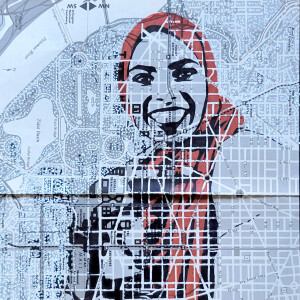
Tuesday Jul 25, 2023
Tuesday Jul 25, 2023
“I smiled in the face of bigotry.”
Shaymaa Ismaa’eel
Muslim who stood up to Islamophobia with joy
The Art:
Ink drawing of Shaymaa Ismaa’eel flashing a bright smile and peace sign while wearing an orange hijab. She’s drawn on a map of Washington, DC, where she encountered the anti-Muslim protestors that inspired her smile.
The Story:
It was a warm spring day in Washington, DC and Shaymaa Ismaa’eel was attending a large Islamic conference when she noticed a loud group of protestors outside brandishing Islamaphobic signs and hurling abuses on the attendees. Their presence was upsetting the attendees, but most tried to hide their feelings and not give the protestors attention.
Ismaa’eel’s friend said to her, “It’s Sunday, It’s Easter. Don’t they have something better to do?” to which Ismaa’eel rejoined, “Clearly, they need something from us,” and she decided to respond to them in a non-confrontational way: she asked her friend to take a photo for her.
In the photo, Ismaa’eel is wearing a hijab and squatting on the curb with a huge smile across her face while flashing a peace sign. The angry protestors and their rude signs and insults served as the backdrop.
She shared the photo on Twitter a couple days later, writing “On April 21st I smiled in the face of bigotry and walked away feeling the greatest form of accomplishment” and on Instagram, with a quote from the Prophet Muhammad saying, “Kindness is a mark of faith. Those who are not kind have no faith.” Her posts quickly went viral, racking up 100,000s of mostly positive interactions online.
“I wanted them to see my joy and to combat their hatred with kindness.” she said of the photo. “There’s a saying from our Prophet saying, ‘Smile is charity,’ and that’s just me personally anyway, always smiling. I wanted to show them that we are going to remain kind and unapologetic and continue to spread love in the face of bigotry.”
A behavioral therapist with children on the autism spectrum near DC, Ismaa’eel continues, “I’m all about being unapologetic about who you are—don’t let anyone dim your light.”
Music:
This episode contains music from Geovane Bruno, SoulProdMusic, and ItsWatR.
Sources:
Anadolu Agency. (2019, April 24). Muslim woman’s pic at anti-Muslim protest goes viral. Daily Sabah. https://www.dailysabah.com/islamophobia/2019/04/24/muslim-womans-pic-at-anti-muslim-protest-goes-viral
Arlington, VA Weather History | Weather Underground. (n.d.). https://www.wunderground.com/history/daily/us/va/arlington/KDCA/date/2019-4-19
BBC News. (2019, April 25). Muslim woman’s picture with anti-Islam protesters goes viral. https://www.bbc.com/news/newsbeat-48048312
Blavity TV. (2019, May 10). Shamyaa Talks About The One Photo That Changed Her Life | Life After Going Viral. YouTube. https://www.youtube.com/watch?v=xEj6Kr6WJCI
Diavolo, L. (2019, April 24). Meet Shaymaa Ismaa’eel, the Muslim Girl Who Posed for Pics in front of Islamophobic Protestors. Teen Vogue. https://www.teenvogue.com/story/meet-shaymaa-ismaaeel-muslim-girl-posed-islamophobic-protestors
Mezzofiore, G. (2019, April 24). This photo went viral when a woman ‘smiled in the face of bigotry.’ CNN. https://edition.cnn.com/2019/04/24/us/woman-smiling-photo-islamophobic-trnd-scli-intl
Muslim Woman Poses with Smile in Front of Islamophobic Protesters: “I Wanted Them to See My Joy.” (2019, April 24). Peoplemag. https://people.com/human-interest/muslim-woman-poses-in-front-of-islamophobic-protesters/
Paul, K. (2019, April 24). “Love in the face of bigotry”: woman takes smiling stand against Islamophobic protesters. The Guardian. https://www.theguardian.com/us-news/2019/apr/23/love-in-the-face-of-bigotry-woman-takes-smiling-stand-against-islamophobic-protesters
Riley, R. (n.d.). Life After Going Viral: Shaymaa Ismaa’eel Shares How She Stood Up To Islamophobia In The Slickest Way Possible - Blavity. Blavity News & Politics. https://www.blavity.com/life-after-going-viral-shaymaa-ismaaeel-shares-how-she-stood-up-to-islamophobia-in-the-slickest-way-possible?category1=culture
@shaymaadarling. (2019, April 23). Twitter. https://twitter.com/ShaymaaDarling/status/1120624558657163264

Tuesday Jul 11, 2023
Tuesday Jul 11, 2023
“How wonderful it is that nobody need wait a single moment before starting to improve the world.”
Anne Frank
Author
The Art:
Ink drawing on a map of Amsterdam, Netherlands. The rooms where Anne Frank and her family and the others spent 25 months hiding from the Nazis are now a museum and it is located to the left of her eyes.
The Story:
Born in 1929 in Germany, Anne Frank and her family moved to the Netherlands when she was four years old to get away from the increasing anti-Semitic persecution under the Nazis. It was not far enough: on May 10, 1940, Hitler’s armies invaded the Netherlands and Belgium on their way to France, bringing their hatred with them.
So, on Monday morning, July 6, 1942, 13-year-old Anne Frank, her parents, and sister secretly moved out of their Amsterdam apartment and into a set of hidden rooms in the annex of her father’s company’s offices. Four other Jews later joined them in this space and a bookcase was placed in front of the door to hide it. With the aid of a few trusted colleagues, the eight of them stayed hidden from the Nazis for 25 months.
Eventually, they were betrayed and on August 4, 1944, the Nazis raided the secret annex. Anne and her companions were all shipped off to concentration camps.
The family’s hiding place was cramped and uncomfortable and the secret residents had to stay very quiet to avoid detection. With little else to do in their attic rooms, Frank passed the time writing in a diary she had received as a birthday gift shortly before they went into hiding. Written as a series of letters to Kitty, an imaginary friend she confided to, Anne documented the events in hiding as well as her thoughts and feelings. It was a therapeutic practice for her, and in one letter to Kitty, Anne wrote, “I can shake off everything as I write; my sorrows disappear, my courage is reborn.”
The diary was more than just a creative outlet for the young Anne. it was a place to let her mind run free—in sharp contrast to her physical realities in hiding.
She would reflect on the beauty of the world, noting to kitty, that “I don't think about all the misery, but about the beauty that still remains. Think of all the beauty still around you and be happy.” And, “How wonderful it is that nobody need wait a single moment before starting to improve the world.”
Not one to be held back by her youth, Anne also wrote, “Although I'm only fourteen, I know quite well what I want, I know who is right and who is wrong. I have my opinions, my own ideas and principles, and although it may sound pretty mad from an adolescent, I feel more of a person than a child, I feel quite independent of anyone.”
Background:
Born: June 12, 1929, Frankfurt, Germany
Died: February 1945, Bergen-Belsen Concentration Camp, Germany
What began as a way to pass the time became a dream of a published book. All told, Frank wrote around 50,000 words longhand in her diary. She didn’t finish the manuscript before her murder. The last letter to Kitty was dated three days before her arrest.
After the Allies liberated Auschwitz, Anne’s father, Otto, returned to Holland to find he was the sole survivor from the eight who had hidden together. He was gifted with Anne’s writings by one of the people who had helped support the family in hiding and had found the papers after the raid.
Otto found Anne’s account deeply moving and decided to fulfill his daughter’s ambition by publishing the diary as a book in 1947. He hoped it would educate readers on the dangers of prejudice and discrimination towards others.
For 25 months, Anne preached love, courage, and hope in the face of evil hatred and oppression. In the decades since, the book has proven her words true that, “In the long run, the sharpest weapon of all is a kind and gentle spirit.” She’s influenced generations of readers, including South African leader Nelson Mandela, who cited Anne as an inspiration during apartheid imprisonment. Today, her diary has been translated into more than 70 languages and sold more than 30 million copies worldwide.
The diary’s enduring impact is summed up in these words Anne wrote after living in hiding for more than two years: “It’s a wonder I haven’t abandoned all my ideals, they seem so absurd and impractical. Yet I cling to them because I still believe, in spite of everything, that people are truly good at heart.”
The Nazi’s arrested Anne and her family three weeks later.
Music:
Sources:
Anne Frank. (n.d.). Jewish Women’s Archive. https://jwa.org/encyclopedia/article/frank-anne
Blakemore, E. (2022, January 27). Who was Anne Frank? Why her legacy is still fought over today. History. https://www.nationalgeographic.com/history/article/who-was-anne-frank
Chandler, G. (2019, November 27). Anne Frank facts. National Geographic Kids. https://www.natgeokids.com/uk/discover/history/general-history/anne-frank-facts/
Digital, P. (2016, July 12). Watch: Nelson Mandela on how Anne Frank’s diary inspired him. Brand South Africa. https://brandsouthafrica.com/61222/watch-nelson-mandela-on-how-anne-frank-s-diary-inspired-him/
History.com Editors. (2020, July 1). Anne Frank. HISTORY. https://www.history.com/topics/world-war-ii/anne-frank-1
Home. (2022, September 27). Anne Frank Website. https://www.annefrank.org/nl/
Special to People’s World. (2015, March 2). Today in women’s history: Death of Anne Frank, Holocaust martyr. People’s World. https://www.peoplesworld.org/article/today-in-women-s-history-death-of-anne-frank-holocaust-martyr/
the Web Editors. (2016, June 10). 8 Anne Frank Quotes to Remember a Young Woman Who Wrestled With. Sojourners. https://sojo.net/articles/8-anne-frank-quotes-remember-young-woman-who-wrestled-suffering
@UNWomen. (2021, January 27). UN Women. Instagram. https://www.instagram.com/p/CKihW0KAmBk/?igshid=19p2fkn2v49v3
Wikipedia contributors. (2022, December 26). Anne Frank. Wikipedia. https://en.wikipedia.org/wiki/Anne_Frank
Wood, S. (2020, December 19). Short Summary of Anne Frank (1929-1945). HistoryColored. https://historycolored.com/articles/4557/anne-frank-1929-1945/
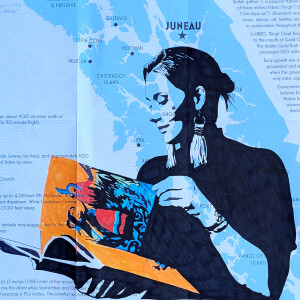
Tuesday Jun 27, 2023
Tuesday Jun 27, 2023
“I contemplated how sorrow, frustration, and anger wove together with courage, resiliency, and hope, and how the art might speak to this gravity.”
Michaela Goade
First Native American illustrator to win the Caldecott Medal
The Artwork:
Ink drawing of Michaela Goade on a map of southeastern Alaska. She is holding an open copy of We Are Water Protectors. Sitka, the ancestral home of her people and where she currently lives, is on the map, directly in her line of sight between her eyes and the open book.
The Story:
It was a Sunday afternoon in 2021 and Michaela Goade was joining a video call with her editor at her publisher, when she saw the Zoom screen filled with many more faces than she was expecting. They were the members of the Caldecott committee and they were sharing the exciting news that Michaela had won the Caldecott Medal that year for her artwork in the book We Are Water Protectors.
The Randolph Caldecott Medal is awarded annually to the illustrator of the most distinguished American picture book for children. She is the first Native American to win the prestigious award.
The author, Carole Lindstrom, wrote We are Water Protectors in response to the Dakota Access Pipeline protests at the Standing Rock Reservation in North Dakota:
In early 2016, local Native Americans began protesting construction of the oil pipeline, viewing the pipeline as a significant threat to Standing Rock’s water sources, as well as a danger to important cultural sites. Beginning with a few hundred, the water protectors’ ranks swelled to over 10,000 and included members of tribal nations from across the United States, as well as people from all over the world, including Tibet and Guatemala. The Trump administration eventually bulldozed over the water protectors’ wishes and completed the pipeline. Oil began flowing through the pipeline in May, with a capacity to transport 750,000 barrels a day.
An enrolled member of the Tlingit and Haida Indian Tribes of Alaska, Goade grew up in Juneau on the traditional lands of her people surrounded by what she describes as, “A labyrinth of over one thousand islands, endless waterways, and wild, rugged coastlines…with a kaleidoscope of glaciers and fjords, rivers and waterfalls, lakes.” Living among the water and as a Tlingit (meaning People of the Tides) the water protectors’ cause touched Goade. She leapt at the opportunity to illustrate Carole’s book.
“Water is a way of life here [in Alaska], and it is our life here in so many different ways. So that core theme really resonated. And I remember, like Carole, feeling helpless during the Stand at Standing Rock,” said Michaela.
Goade painted her illustrations for We Are Water Protectors over several months in 2018. Painting her vibrant watercolors in a tiny studio next to the sea, Goade, hoped her art would inspire a new generation of water protectors:
“I contemplated how sorrow, frustration, and anger wove together with courage, resiliency, and hope, and how the art might speak to this gravity. In this book, it was especially crucial that all children, Native and non-Native alike, came away from the experience feeling autonomous and empowered,” she said in her Caldecott acceptance speech.
As for the Dakota Access Pipeline that inspired the book, litigation is ongoing on both sides. The pipeline has leaked at least 5 times as of 2021.
Background:
Trained in graphic design and working as an art director at a marketing agency, Goade got her start illustrating children’s books with 2017’s Shanyaak’utlaax: Salmon Boy, a story about respecting the natural world.
“Picture books spoke my language like nothing before had. They became a way to reconnect with my culture, find my artistic voice and give back to the Native community in a unique way,” she says of the career change. “Children’s books are reflections of our society. They often communicate who is visible and important in today’s world. Therefore, representation that reflects the very diverse experiences of Native Americans is much needed.”
Since Salmon Boy, Goade has illustrated several award-winning books, including Berry Song in 2022, her first release as an author.
Music:
Theme music comes from Geovane Bruno. Other music in this episode comes from water protectors inspired by the Standing Rock protests, including Taboo, Aliza Hava, and Dee Snider.
Sources:
ABC News. (2022, July 19). Caldecott Medal winner creates celebration of land she knows well in new book l ABCNL. YouTube. https://www.youtube.com/watch?v=dp3UdtIq6w0
AP. (2021, January 26). Illustrator Michaela Goade Becomes First Native American To Win Caldecott Medal. HuffPost. https://www.huffpost.com/entry/michaela-goade-caldecott-meda_n_60100cdbc5b634dc37384d3d
Danielson, J. (n.d.). A Conversation with Michaela Goade. The Horn Book. https://www.hbook.com/story/a-conversation-with-michaela-goade
Day, C. (2019, September 1). q&a with michaela goade! Christine Day. https://www.bychristineday.com/blog/2019/9/1/qampa-with-michaela-goade
Elbein, S. (2021, May 4). These Are the Defiant “Water Protectors” of Standing Rock. Culture. https://www.nationalgeographic.com/culture/article/tribes-standing-rock-dakota-access-pipeline-advancement
Goade, M. (n.d.-a). 2021 Caldecott Medal Acceptance by Michaela Goade. The Horn Book. https://www.hbook.com/story/2021-caldecott-medal-acceptance-by-michaela-goade
Goade, M. (n.d.-b). About the artist. MichaelaGoade.com. https://www.michaelagoade.com/about
McKinstry, E. (2021, February 17). Finding activism through art: A Q&A with Tlingit illustrator Michaela Goade. KTOO. https://www.ktoo.org/2021/02/17/finding-activism-through-art-a-qa-with-tlingit-illustrator-michaela-goade/
Michaela Goade. (2022, November 8). Wikipedia. https://en.wikipedia.org/wiki/Michaela_Goade
Michaela Goade: Taken by Surprise on Zoom. (n.d.). PublishersWeekly.com. https://www.publishersweekly.com/pw/by-topic/childrens/childrens-authors/article/85409-michaela-goade-taken-by-surprise-on-zoom.html
Miller, C. (2018a, February 14). Michaela Goade-illustrated book wins ‘best picture book of the year.’ Juneau Empire. https://www.juneauempire.com/news/michaela-goade-illustrated-book-wins-best-picture-book-of-the-year/
Miller, C. (2018b, February 14). Michaela Goade-illustrated book wins ‘best picture book of the year.’ Juneau Empire. https://www.juneauempire.com/news/michaela-goade-illustrated-book-wins-best-picture-book-of-the-year/
Native Voices: Author & Illustrator Interview: Carole Lindstrom & Michaela Goade. (2020, May 19). Cynthia Leitich Smith. https://cynthialeitichsmith.com/2020/05/native-voices-author-illustrator-interview-carole-lindstrom-michaela-goade/
Shah, S. (2021, October 13). This Native American Illustrator Is Bringing Indigenous Stories to Life—and Opening the Door for Others. Time. https://time.com/6103213/michaela-goade-next-generation-leaders/
Staff, K. (2021, February 1). Sitka illustrator Michaela Goade wins Caldecott Medal for “We are Water Protectors.” KCAW. https://www.kcaw.org/2021/01/28/sitka-illustrator-michaela-goade-wins-caldecott-medal-for-we-are-water-protectors/
TIME. (2021, October 18). Michaela Goade | Next Generation Leaders. YouTube. https://www.youtube.com/watch?v=IqaFKvzjMuY
Wikipedia contributors. (2022, November 1). Dakota Access Pipeline. Wikipedia. https://en.wikipedia.org/wiki/Dakota_Access_Pipeline

Thursday Jun 22, 2023
Thursday Jun 22, 2023
Coming June 27, Fearless Portraits returns for a second season telling stories of women who worked to change the world.

Tuesday Dec 06, 2022
Tuesday Dec 06, 2022
I’ve been working hard collecting new stories and drawing portraits of amazing women that will be coming to your podcast feed for Season 2 in the new year. But for now, here is an interview I did this week with John and Rachel, hosts of the YaJagoff! show on Pittsburgh’s Q92.9 FM about the Fearless Portraits art project.
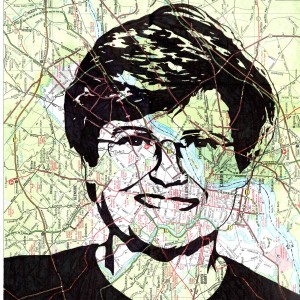
Tuesday Sep 20, 2022
Tuesday Sep 20, 2022
“Redemption! I was grabbing the air, I got so excited I was afraid I might die or something.”
Dr. Katalin Karikó
Biochemist who pioneered mRNA, the technology behind the successful COVID-19 vaccines from Pfizer/BioNTech and Moderna.
The Artwork:
Ink drawing on a map of Philadelphia, PA. The University of Pennsylvania where she did much of her research is located near her chin.
The Story:
Doubted and then demoted by academic leaders, denied grants, and derided by her peers, Katalin Kariko’s journey from disregarded scholar to world savior was a four-decade struggle. Introduced to the concept of messenger RNA (mRNA) during her undergraduate, she quickly saw the possibilities and pursued a PHD in the field, beginning in 1978. Ultimately, her research served as the basis of the Pfizer/BioNTech and Moderna coronavirus vaccines.
In 1985, Karikó left her native Hungary with her husband, two-year-old daughter, and $1,200 sewn into teddy bear (proceeds from selling the family car on the black market). She continued her research at Temple University before moving to the University of Pennsylvania in 1989. All the while, rejected grant applications piled up on Karikó’s desk. She said her mRNA research was “too novel” to get funded.
By 1995, her bosses at the university were growing impatient with the lack of funding and offered a humiliating choice: leave or be demoted to adjunct from her prestigious tenure-track position. With the demotion came a substantial pay cut. The same week, she was diagnosed with cancer.
“Usually, at that point, people just say ‘goodbye’ and leave because it’s so horrible,” she says. But Karikó wasn’t like usual people. Undeterred by the setbacks, she doggedly continued in her research. One year, she recalled realizing in May that she had worked every day that year, including New Year’s Day, even sleeping in the office sometimes.
A few years later, a chance meeting with Drew Weissman at a photocopier changed the course of her career. A respected immunologist, Weissman was intrigued with Karikó’s research. More important, he had the funding to finance her experiments in his lab. This partnership “gave me optimism and kept me going,” says Karikó. “My salary was lower than the tech who worked next to me, but Drew was supportive and that’s what I concentrated on.”
In 2005, Karikó finally had a breakthrough. On paper, mRNA was simple, in reality injecting synthetic mRNA often led to disastrous immune responses from subjects. Karikó and Weissman figured out how to sneak mRNA into cells without triggering the alarm bells. This paved the way for vaccines and other future therapies with mRNA.
Despite this success, the University of Pennsylvania told Karikó in 2013 she was “not of faculty quality.” She left to become Senior Vice President at BioNTech, a nascent German biotech firm. “When I told them I was leaving, they laughed at me and said, ‘BioNTech doesn’t even have a website.’”
Her career’s research has since served as the basis of the highly effective COVID-19 vaccines developed by Pfizer/BioNTech and Moderna.
She screamed, “Redemption!” upon hearing the news the vaccine was effective. “I was grabbing the air, I got so excited I was afraid I might die or something. I never doubted it would work.”
She celebrated by eating a bag of chocolate-covered peanuts. “
Background on mRNA:
The focus of Karikó’s career was mRNA, a single-stranded messenger molecule that delivers instructions from the DNA in the cell’s nucleus to the protein-making centers called ribosomes. Without mRNA, DNA would be useless, leading some to call mRNA the “software of life.”
MRNA offers a way for the body to heal itself and its promise will likely be realized in ways far beyond the current COVID-19 vaccine application. With the COVID-19 vaccine, the mRNA tells cells to create harmless spike proteins to prepare the immune system to fight against coronavirus’ spikes. Other possibilities include other vaccines, treating cancer, and diseases like cystic fibrosis.
Music:
This episode contains music by Geovane Bruno, Coma Media, Hot_Music, Oleksandr Savochka, and 24414830.
Sources:
BioNTech scientist Katalin Karikó risked her career to develop mRNA vaccines. Americans will start getting her coronavirus shot on Monday. (2020, December 12). Business Insider. https://www.businessinsider.com/mrna-vaccine-pfizer-moderna-coronavirus-2020-12?international=true&r=US&IR=T
Corbley, A. (2021, February 1). She was Demoted, Doubted and Rejected But Now Her Work is the Basis of the Covid-19 Vaccine. Good News Network. https://www.goodnewsnetwork.org/katalin-kariko-hungarian-chemist-developed-covid-19-mrna-vaccine/
Cox, D. (2020, December 2). How mRNA went from a scientific backwater to a pandemic crusher. WIRED UK. https://www.wired.co.uk/article/mrna-coronavirus-vaccine-pfizer-biontech
Garde, D., & Globe, J. S. —. B. (2021, January 7). The story of mRNA: How a once-dismissed idea became a leading technology in the Covid vaccine race. STAT. https://www.statnews.com/2020/11/10/the-story-of-mrna-how-a-once-dismissed-idea-became-a-leading-technology-in-the-covid-vaccine-race/
Kolata, G. (2021, September 24). Kati Kariko Helped Shield the World From the Coronavirus. The New York Times. https://www.nytimes.com/2021/04/08/health/coronavirus-mrna-kariko.html
Kollewe, J. (2020, November 23). Covid vaccine technology pioneer: “I never doubted it would work.” The Guardian. https://www.theguardian.com/science/2020/nov/21/covid-vaccine-technology-pioneer-i-never-doubted-it-would-work
Newey, S., & Nuki, P. (2020, December 2). “Redemption”: How a scientist’s unwavering belief in mRNA gave the world a Covid-19 vaccine. The Telegraph. https://www.telegraph.co.uk/global-health/science-and-disease/redemption-one-scientists-unwavering-belief-mrna-gave-world/
Wikipedia contributors. (2022, July 22). Katalin Karikó. Wikipedia. https://en.wikipedia.org/wiki/Katalin_Karik%C3%B3

Tuesday Sep 06, 2022
Tuesday Sep 06, 2022
“I interested Miss Alice Ball… in the chemical problem of obtaining… the active agents in the oil of chaulmoogra. After a great deal of experimental work, Miss Ball solved the problem.”
Dr. Harry Hollmann
Writing about chemist Alice Ball and her groundbreaking cure for leprosy in a scientific journal
The Artwork:
Ball’s portrait in the Fearless Portraits project consists of an Ink drawing on a map of Honolulu, HI. The University of Hawaii where she worked is visible on the bridge of her nose. Wearing a graduation cap and gown, the portrait is based on the only known photograph of Ball.
The Story:
An ancient disease, leprosy (also known as Hansen’s Disease) has afflicted humans since biblical times. Viewed as a shameful curse, for most of history, leprosy was “treated” by throwing victims out of their homes and isolating them in leper colonies where they lived in poverty and pain as their disease progressed and complications eventually killed them. That is, until 1916, when a 23-year-old Alice Ball developed the first cure for the skin disease.
Born in 1892 in Seattle, Washington, Ball excelled in science and she earned bachelors’ degrees in chemistry and pharmacy at the University of Washington and went to what is now the University of Hawaii to pursue a master’s degree in chemistry. After graduating as the first black woman to earn a master’s degree at the school, she was invited to teach chemistry, becoming the first woman to teach there.
While teaching college chemistry, she was approached by Harry Hollman, a doctor treating leprosy patients. At his suggestion, she began researching the problem of using chaulmoogra oil as a treatment /
for leprosy. Chaulmoogra oil had been used to treat leprosy for hundreds of years, but it was difficult to administer to patients and not very effective. Ball was able to isolate the relevant compounds in the oil and developed a technique for injecting the oil. The results were very successful.
Sadly, she died a few months later before her findings could be published. A male colleague stole her research and named the discovery after himself. He received accolades from around the world for his stolen leprosy cure and later parlayed his success into the presidency of the university.
Hollman attempted to set the record straight six years later in 1922, writing in a scientific journal, “I interested Miss Alice Ball, M.S., an instructress in chemistry at the College of Hawaii in the chemical problem of obtaining for me the active agents in the oil of chaulmoogra. After a great amount of experimental work, Miss Ball solved the problem for me by making the ethyl esters of the fatty acids found in chaulmoogra oil, employing the technic herewith described,” which he referred to as “Ball’s Method.”
The Ball Method was far more efficacious than the previous topical and oral chaulmoogra oil therapies and thousands of leprosy patients around the world were successfully treated with it. The Ball Method remained the standard for leprosy treatment until the 1940s, when new classes of drugs were developed.
Ball became ill during her research and returned to Seattle for treatment. She died at the age of 24 on December 31, 1916. The cause of death is unknown, although it may have been due to chlorine gas exposure during a lab accident. Whatever the case, she wasn’t around to defend her work and despite Hollman’s 1922 article, Ball remained in obscurity for decades.
It was not until 2000, that the University of Hawaii recognized Ball with a plaque on campus, at the urging of scholars Dr. Kathryn Takara and Stan Ali. Around the corner from the plaque is the stately hall named for Ball’s research thief. Also in 2000, the Governor of Hawaii named February 29 “Alice Ball Day.” Other honors and accolades have since been bestowed on Ball.
Music:
This episode contains music by Geovane Bruno, Aleksandr Karabanov, and DayFox.
Sources:
Ball, Alice Augusta. (n.d.). ScholarSpace | University of Hawaiʻi at Mānoa. https://scholarspace.manoa.hawaii.edu/handle/10125/1837#:%7E:text=On%20February%2029%2C%202000%2C%20the,lone%20chaulmoogra%20tree%20on%20campus.
Bennett BH, Parker DL, Robson M. Leprosy: steps along the journey of eradication. Public Health Rep. 2008 Mar-Apr;123(2):198-205. doi: 10.1177/003335490812300212.
Brewster, C. D. (2021, May 4). How the Woman Who Found a Leprosy Treatment Was Almost Lost to History. National Geographic. https://www.nationalgeographic.com/science/article/alice-ball-leprosy-hansens-disease-hawaii-womens-history-science
Hollman, H. T. (1922). The Fatty Acids of Chaulmoogra Oil in the Treatment of Leprosy and Other Diseases. Archives of Dermatology and Syphilology, 5(1), 94–101. https://doi.org/10.1001/archderm.1922.02350260097010
Knutsen, E. (2018, August 25). This phenomenal young woman found a cure for leprosy, but the man she worked with got the credit. Timeline. https://medium.com/s/the-matilda-effect/alice-ball-matilda-effect-6b5fb64c74d6
Parascandola J. Chaulmoogra oil and the treatment of leprosy. Pharm Hist. 2003;45(2):47-57. Retrieved from https://lhncbc.nlm.nih.gov/LHC-publications/PDF/pub2003048.pdf
Wikipedia contributors. (2022, July 30). Alice Ball. Wikipedia. https://en.wikipedia.org/wiki/Alice_Ball
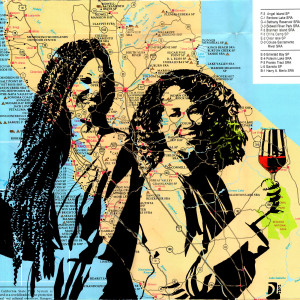
Tuesday Aug 16, 2022
Tuesday Aug 16, 2022
“It’s definitely an old boys’ club, and so obviously for us coming in as opposite, we definitely were looked at as not just not belonging, but really incapable of being successful.”
Robin McBride
Co-founded McBride Sisters Wine Company with Andréa McBride, the largest Black-owned wine company in the US
The Artwork:
The McBride’s portrait in the Fearless Portrait project consists of an ink drawing of the two of them on a map of California. Both wearing suits, and clasping wine glasses in their hands, Robin is on the left and Andréa is on the right. Monterey, CA, where Andréa grew up and where some of their wine is from, is located on the right side of Robin.
The Story:
The journey to building one of the largest Black-owned wine companies in the world began in very unlikely circumstances. Andrea McBride was a teenager living in foster care in New Zealand when she got a phone call from her estranged biological father in Alabama. He was calling to deliver the double shot of surprise news that he was dying of cancer and before he died, he wanted to connect her with his other daughter—Robin—whose existence Andrea had never known of.
He died before they could find Robin, but Andrea did get to meet her father’s family and they sent letters to every Robin McBride in the phone book until they finally found the right Robin. She was living across the country in Monterey, CA.
When they finally got to speak to each other for the first time in 1999, one of their ice breaker questions was “what was it like where you grew up?” and they discovered they both grew up in winemaking areas and they were passionate about wine. In an effort to bond, they went to wine tastings and vineyard tours. After a few glasses of wine, they started to dream about having their own wine company together.
That dream became a reality in 2005, when they scraped together the $1,800 to buy an importer’s license and began selling New Zealand sauvignon blanc to high-end restaurants. Their operation continued to grow and in 2016, they took it a leap further and formed the McBride Sister’s Wine Company. In 2020, the company cleared $5.5m in sales.
Selling wines from each of their homelands, New Zealand and California, McBride Sisters Collection wines are available across the US.
The journey from first importing wine to creating a multi-million dollar wine business was not an easy one. They built their company without any investors or advisors in the beginning and faced challenges in a sector that is “notorious for its gatekeeping,” says Robin.
“It’s definitely an old boys’ club,” says Robin of the wine industry. “A large part of the industry is run by a very small group of older white wealthy men. There are a lot of dynasties in wine and family lineages that still run things. And so obviously for us coming in as the opposite—really of everything that, to that point, had been successful in the wine world, which was an older white man—we definitely were looked at as not just not belonging, but really incapable of being successful.”
The traditional way to sell wine was to work with wholesalers, distributors, and retailers, working each step like a ladder until the bottles eventually made it to store shelves. The McBrides found ways to bypass these gatekeepers by creating demand directly with customers.
“A lot of our experiences of us being curious about wine and how we were treated when we were in those tasting rooms and stuff is really a lot of the foundation of what our company is built on today, which is making wine accessible for everybody and helping people on their journey and making it fun,” says Andréa.
This customer-centric philosophy around wine helped propel their business into the largest Black-owned wine company in the US.
Background:
Beyond their own wine business, the McBrides are passionate about elevating women and people of color by raising a more diverse generation of winemakers and consumers.
“Our purpose and our mission,” says Andréa, “Is to change the face of wine for our community and for our industry. When we talk about our community, who we serve, we find that who is attracted to our brands are women and people of color. This is a really big group of people that the wine industry doesn't do that great a job in welcoming. For a long time, we have been one of the only Black-owned brands that has national distribution that is available at national grocery stores. We want to leave the wine industry better than when we started. We don't think that we should be the only ones here.”
In 2019, they launched the SHE CAN line of canned wines, which underwrites the SHE CAN Fund. A concerted effort to help close the gender and race gap in the wine world, the fund has contributed more than $3 million in scholarships, in-kind skills development, technical training, and ad credits to women vintners.
Music:
This episode contains music by Geovane Bruno and MusicTown.
Sources:
Brooks, S. (2021, August 30). 20 Minutes With: The McBride Sisters, Founders of the Largest Black-Owned Wine Brand in the U.S. Barron’s. https://www.barrons.com/articles/20-minutes-with-the-mcbride-sisters-founders-of-the-largest-black-owned-wine-brand-in-the-u-s-01630349788
How I Built This. (2020a, October 19). McBride Sisters Wine (Part 1 of 2): Robin McBride and Andréa McBride John. NPR. https://www.npr.org/2020/10/15/924227706/mcbride-sisters-wine-part-1-of-2-robin-mcbride-and-andr-a-mcbride-john
How I Built This. (2020b, October 23). McBride Sisters Wine (Part 2 of 2): Robin McBride and Andréa McBride John. NPR. https://www.npr.org/2020/10/23/927158151/mcbride-sisters-wine-part-2-of-2-robin-mcbride-and-andr-a-mcbride-john
Richardson, R. (2022, April 5). McBride Sisters Helm the Country’s Largest Black-Owned Wine Brand. TODAY.Com. https://www.today.com/food/people/mcbride-sisters-largest-black-owned-wine-company-in-us-rcna22036
Worobiec, M. (2020, October 27). Wine’s Dynamo Sister Team. Wine Spectator. https://www.winespectator.com/articles/wines-dynamo-sister-team

Tuesday Aug 02, 2022
Tuesday Aug 02, 2022
“It is never a waste to try something and fail.”
Masako “Ma-chan” Wakamiya (若宮正子)
Octogenarian app developer
The Artwork:
Ma-chan’s portrait in the Fearless Portraits project consists of an Ink drawing on a map of Kanagawa, the prefecture she lives in, just south of Tokyo. She’s seated on the floor next to a traditional Japanese short-legged table with a laptop open on it.
The Story:
Masako “Ma-chan” Wakamiya got her first computer when she retired from a career in a bank in 1997. She found a whole new world available to her through her computer and relished the connection and community the internet offered, saying, “at the age of 60, my world expanded—I got wings!”
Ma-chan’s interest in technology continued from PCs to smartphones. As the resident tech expert in her circle, she spent a lot of time helping her friends and neighbors use their phones and she theorized older people have a hard time with smartphones and such because apps and games mostly catered to young people—either by using small print, requiring fast play, or using difficult swiping motions.
Sensing an opportunity, she thought a possible solution to help older people be more comfortable with their devices would be an app designed for them. So, at the age of 82, she set about creating an app for her peers. She settled on a game based on Japan’s annual doll festival (called Hinamatsuri).
“I wanted to make games that would allow us seniors to defeat even young people on the basis of our knowledge―games that are different from the competitive ones that require quick reflexes,” she says. “As we age, our eyesight gets worse, and we can't move our fingers the way we'd like to. This game is designed so that even people with these problems can enjoy it.”
She reached out to the president of an app development company she had met through volunteer work previously and presented her idea. He countered with a suggestion that she create the app herself and he would teach her over Skype.
Never one to back down from a challenge, Ma-chan dove into app development, persevering through a difficult six months to build the app.
“It was especially very difficult to organize the whole structure of the app,” she says of the challenge of learning to code. Plus most of the resources she found online to learn from were in English, adding a further level of difficulty to the project.
“It is never a waste to try something and fail,” Ma-chan said of the fits and starts she experienced while learning to code. “You will not die or get injured even if things don't pan out well. It's best to enjoy your failures. If you fail, you fail. What's wrong with that?”
The game, called Hinadan, was completed just in time for the doll festival in 2017.
In the app, players move dolls in a puzzle into their appropriate positions based on the dolls’ roles (emperor, empress, and so on). The app has now been released in five languages.
Given her status as perhaps the oldest app developer in the world, news of the app went viral.
Apple CEO Tim Cook invited her to Apple’s annual Worldwide Developer Conference where Ma-chan got to meet him and the two discussed the app together. “It was as if we were chatting in a programming class,” she said of the experience.
Background:
Born in 1935 in Tokyo, the app is just the latest chapter in Ma-chan’s self-proclaimed role of “IT evangelist” where she encourages seniors to use digital technology to enrich their lives. She spreads her message through the lecture circuit in Japan and abroad, including a TEDx Talk in Tokyo and an address before a UN conference in New York. She’s also written several books, primarily around educating seniors with technology.
Another way she has taught tech skills is something she calls “Excel art.” Which is using Excel spreadsheets to create patterns. “Excel looks difficult for seniors. But I came up with an idea of drawing designs using its functions. Then, I got so excited as I was able to produce one new pattern after another,” she says.
Music:
This episode contains music by Geovane Bruno, OB-LIX, FreeGroove, and Solbox.
Sources:
AFP TV. (2017, August 7). Never too old to code: Meet Japan’s 82-year-old app-maker. https://www.youtube.com/watch?v=BXnjNCX6Ai4
CNA Insider. (2018, February 25). 81 And Excelling | Super Octogenarians | CNA Insider. YouTube. https://www.youtube.com/watch?v=e7uN4-NiG0s
JapanGov. (2018). Game App Developer in Her 80s Opens ICT World for Fellow Seniors /. The Government of Japan - JapanGov -. https://www.japan.go.jp/tomodachi/2018/spring-summer2018/game_app_developer.html
Kambayashi, T. (2022, March 9). At 82, she coded an app. She just wanted a game she could win. The Christian Science Monitor. https://www.csmonitor.com/World/Making-a-difference/2022/0309/At-82-she-coded-an-app.-She-just-wanted-a-game-she-could-win
Kashima, Y., & Armitage, S. (2017, June 13). Meet The 82-Year-Old App Developer Who Says Life Gets Better With Age. BuzzFeed News. https://www.buzzfeednews.com/article/yuikashima/this-82-year-old-grandmother-is-an-apple-developer
Nikkei. (2019, November 23). Meet the 84-year-old Japanese app developer who inspired Tim Cook. Nikkei Asia. https://asia.nikkei.com/Business/Technology/Meet-the-84-year-old-Japanese-app-developer-who-inspired-Tim-Cook2
Self Taught Japanese. (2017, June 6). 82 year old Japanese woman’s “hinadan” mobile app: sometimes it takes new technology to uncover ancient traditions. https://selftaughtjapanese.com/2017/06/06/82-year-old-japanese-womans-hinadan-mobile-app-sometimes-it-takes-new-technology-to-uncover-ancient-traditions/
TED. (n.d.). TEDxTokyoSalon | TED. TED Talks. https://www.ted.com/tedx/events/15791
Wakamiya, M. (n.d.). Masako Wakamiya. Amazon. https://www.amazon.com/Masako-Wakamiya/e/B004LR7TIO%3Fref=dbs_a_mng_rwt_scns_share
Wakamiya, M. (2014, May 31). Now is the time to get your own wings | Masako Wakamiya | TEDxTokyo. TEDx Tokyo. https://www.youtube.com/watch?v=gUjXiYtOC7Y&t=644s
Wakamiya, M. (2017, February 23). hinadan. App Store. https://apps.apple.com/us/app/hinadan/id1199778491
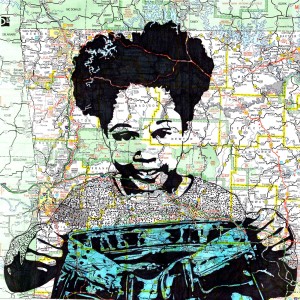
Tuesday Jul 19, 2022
Tuesday Jul 19, 2022
“I do not like that the front pockets of girls jeans are fake.”
Kamryn Gardner
First grader who asked Old Navy to make jeans with pockets
The Artwork:
Gardner’s portrait in the Fearless Portraits project consists of an Ink drawing of her holding her new pocketed jeans on a map of northern Arkansas. Bentonville, where she lives is located just over her head and the left.
The Story:
Seven-year-old Kamryn Garder of Bentonville, AR had a small problem: Her pants had no pockets. She desperately wanted pockets to put her hands in and stash items. Her brother’s pants had pockets but on hers, the “pockets” were strictly ornamental.
After learning about persuasive writing in school, the first grader put the lesson into action. On the advice of her mother, she wrote a letter to retailer Old Navy. With neat penciled letters on large-ruled paper, she took the company to task for shortchanging girls out of their pockets
Dear Old Navy,
I do not like that the front pockets of the girls jeans are fake. I want front pockets because I want to put my hands in them. I also would like to put things in them. Would you consider making girls jeans with front pockets that are not fake. Thank you for reading my request.
Sincerely,
Kamyrn Gardner, age 7
Gardner’s brother, Landon, 9, found her argument persuasive, saying, “I’ve never had this problem [of no pockets]. But I’ve heard my sister talk about not having pockets all the time.”
The logic worked on Old Navy also and the company responded with a note about her “great feedback for us as we develop new product,” and a package of four pairs of jeans in her size. With pockets of course.
Less successful was Gardner’s efforts at writing persuasive letters to her parents to get her a camera.
Background on pockets in women's and girl's clothes
Gardner isn’t the first to rail against the lack of functional pockets in women’s clothing. Women lost their pockets two centuries ago, when closer-fitting dress styles came in vogue in the 1790s. Before then, women’s pockets were essentially bags hanging from a strap around the waist and tucked under a skirt. With fluffy skirts and petticoats, the pockets were invisible. When styles changed, pockets were left behind to avoid bulges. Meanwhile, men have always enjoyed pockets.
Beginning in the 20th century, pockets for women have repeatedly come back, only to leave again, depending who’s winning the tug-of-war between practicality and fashion, (or if you prefer, empowerment and misogyny). as Christian Dior put it, “Men have pockets to keep things in, women for decoration.”
Gardner’s complaint is about more than having a place for her hands. As writer Gail Cornwall noted in The Washington Post:
“Not having pockets limits girls’ ability to experience. Not only do pockets free a child’s hands to investigate and accomplish, they also broadcast the need and right to do so to both wearer and viewer alike. Or, more accurately, it’s the contrast of the presence and absence of pockets in different kids’ clothing that sends a two-part message: Only men need functionality, and girls should learn to be women as early as possible.”
Music:
This episode contains music by Geovane Bruno, Coma Media, and Music Unlimited.
Sources:
Bentonville Schools [@ BentonvilleSchools]. (2021, April 1). Oh, the power of persuasion especially when you’re adorable! Earlier this year, first graders at Evening Star Elementary practiced writing [Facebook post]. Facebook. https://www.facebook.com/BentonvilleSchools/posts/10157778570856366
Burman, B. (2002). Pocketing the Difference: Gender and Pockets in Nineteenth-Century Britain. Gender History, 14(3), 447–469. https://doi.org/10.1111/1468-0424.00277
Cornwall, G. (2020, January 15). Why girls need pockets. Washington Post. https://www.washingtonpost.com/outlook/2020/01/15/why-girls-need-pockets/
Free, C. (2021, April 9). First-grader wrote Old Navy asking for girls’ jeans to have real pockets. The letter went viral. Washington Post. https://www.washingtonpost.com/lifestyle/2021/04/09/old-navy-girls-jeans-pockets/
Pelletiere, N. (2021, April 8). Old Navy responds to 1st grader’s request for girls’ jeans with real pockets. Good Morning America. https://www.goodmorningamerica.com/family/story/navy-responds-1st-graders-request-girls-jeans-real-76923645
Ushe, N. (2021, April 8). Old Navy Tells First-Grader They Plan to Develop Pockets in Girls’ Jeans After She Writes Them a Letter. PEOPLE.Com. https://people.com/human-interest/old-navy-tells-first-grader-they-plan-develop-pockets-girls-jeans-after-letter/

Contact
Know of an amazing woman who should be profiled in this podcast and art project? Please share their story! I’m always looking for more people to include. Any other questions, comments, or concerns?
Email: artwork (at) danlandau.net
Instagram: @danlandauart
Hear the latest news first
Join my mailing list for news about the show, giveaways, commission openings, and more.
I'll only email you when I have something important to say, so I promise not to overrun your inbox.
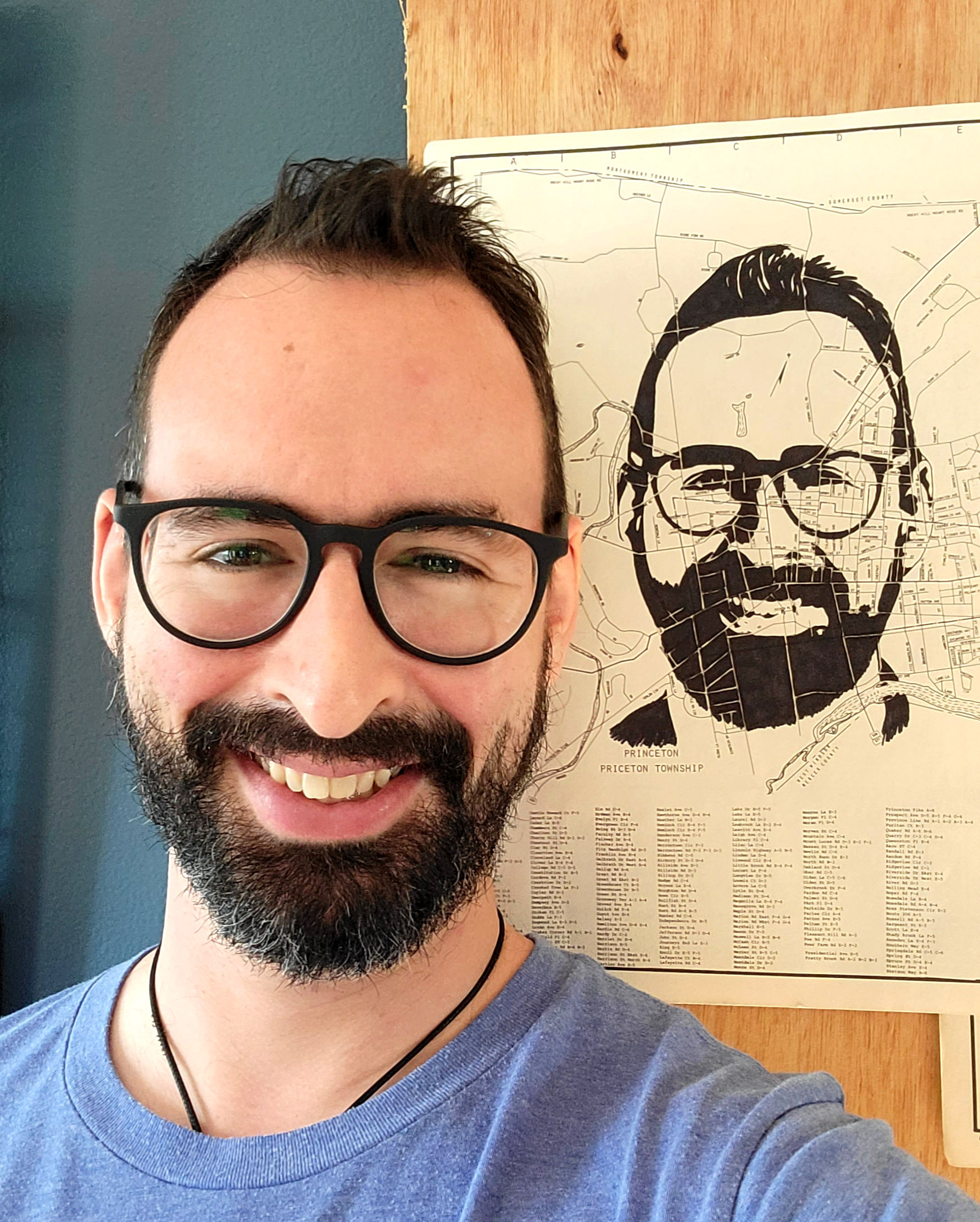
Your host Dan Landau
I am a self-taught artist specializing in figurative works drawn on maps. My work has been published in a variety of outlets, including The New York Times, Huff Post, and The Nation, and is held in private collections around the world. I live in New Jersey with my favorite muses: my wife and two daughters.
Why maps?
I’ve always liked maps. As a kid, I pored over the map inserts that came with my National Geographic magazines. Now, I use maps as my canvas for creating art.
My work typically consists of subjects drawn in ink on paper maps. Sometimes I cut away portions of the map, leaving the drawing and the roads behind. I like to work with maps because maps have quite a bit of meaning baked into them. They represent places with special associations for us. They help us get to know new places. I use maps as a metaphor for connection and exploration in my work.
Map selection is a crucial part of my process. Sometimes my subjects are deeply and obviously entwined with the maps I draw them on—for example, women profiled in the Fearless Portraits series are drawn on maps of locations connected to their stories. Sometimes the connection is more abstract—evoking ideas of a journey and philosophical travel. Or, perhaps I just liked how the curve of a road matched the subject’s nose.








